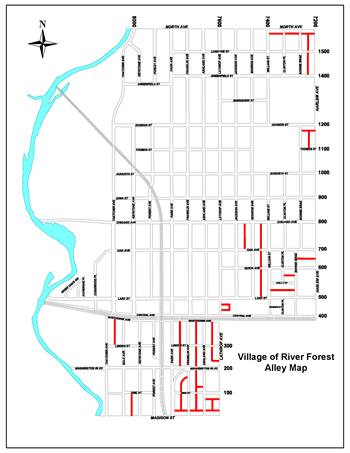River Forest has plans to green 85 percent of the village’s alleyways using permeable pavements. The voluntary stormwater capacity of the recently completed green alleys is now available for trade within the StormStore™ market through Metropolitan Water Reclamation District's stormwater trading pilot program.

Village of River Forest
A green alley in River Forest, Illinois, completed in 2019

Courtesy of Village of River Forest
Map of alley locations within River Forest, Illinois
Over the last decade, Jeff Loster, Director of Public Works and Development Services for the Village of River Forest, has become an expert on constructing an essential type of urban stormwater infrastructure—the green alley. Now, Mr. Loster and his colleagues at the Village are taking advantage of an innovative program to attract new development to River Forest.
The program—Metropolitan Water Reclamation District’s (MWRD) Stormwater Trading Pilot—is a result of partnership between the Metropolitan Planning Council (MPC) and The Nature Conservancy (StormStore™) to create opportunities for municipalities like River Forest to generate revenue from investments in public stormwater assets. If successful, the Village may use the capacity of these green alleys to offsite the stormwater management requirements elsewhere in the village. Until that development happens, the capacity generated by the green alleys remains on the books (or, in the “bank”) in the StormStore registry.
Like many older suburbs in Cook County, the Village of River Forest uses a combined-sewer system to collect and convey waste water and stormwater through a series of underground pipes to MWRD, the region's sewer authority. When the Village experiences heavy rain storms, many residents experience the unpleasant downsides of a combined sewer: backup in basements, flooding in streets, or soggy yards and parks. For River Forest, green alleys are a logical tool to address these issues because they deliver multiple benefits—not only helping to alleviate local flooding but also upgrading and improving the alleyways that serve the community.
The first four-block segment of green alleys constructed in River Forest nearly a decade ago were funded in part by the Illinois Environmental Protection Agency’s (IEPA) Illinois Green Infrastructure Grant (IGIG) program. At the time the Village was an early adopter of the “green alley” concept, building on prominent examples from the City of Chicago’s Green Alleys program. Today, River Forest is a leader in its own right with plans to complete 14 additional green alleys in 2022-23. This would result in the greening of an impressive 27 of 32 total village alleys.
Like the Village of Franklin Park, located just north along the Des Plaines River, River Forest is an early entrant into the StormStore marketplace. Also like Franklin Park, River Forest intends for credits to be used only within municipal boundaries. One key difference between the approaches taken by the villages is that River Forest is aggregating multiple relatively small projects into a larger credit bank that could be used to offset the regulated requirements of larger development sites. The two Watershed Management Permits that represent the most recently completed green alleys in River Forest provide approximately 0.22 acre-feet of voluntary Volume Control.
While it is too early to know the value of a stormwater credit, the estimates from workshops and interviews conducted by StormStore with developers and engineers familiar with these type of projects anticipate that the going rate for volume control projects could be between $125,000 and $250,000 per acre-foot of volume control provided. If that range is accurate, the combined 0.2187 acre-feet of volume control permitted under these two permits could have a current market value of approximately $27,500 to $54,700—a number that could grow with the addition of each new green alley.
Mr. Loster has a good vantage point to understand how green alleys benefit his community. He started with the Village as an engineer in 2013, to implement those first IGIG-funded green alleys. Since that time, he has completed 13 green alleys throughout the village. “We’ve tweaked the designs [of the green alleys] along the way,” says Mr. Loster, but the general profile remains the same, with water draining toward the centerline of the alley where a three- to four-foot-wide band of permeable pavement exists to capture and infiltrate the stormwater.
If the past is any indicator, the village is on track to leverage the benefits of green alleys and other types of green infrastructure for its residents well into the future. StormStore is happy to partner with River Forest to bring added benefits through stormwater credit trading.